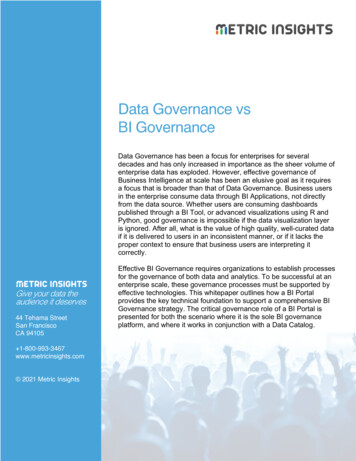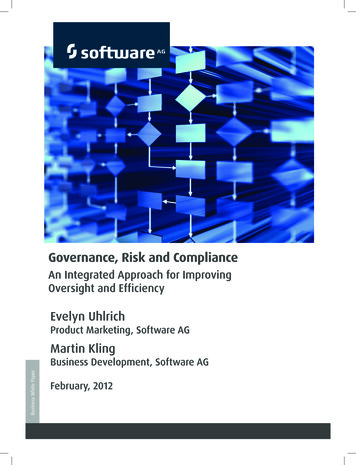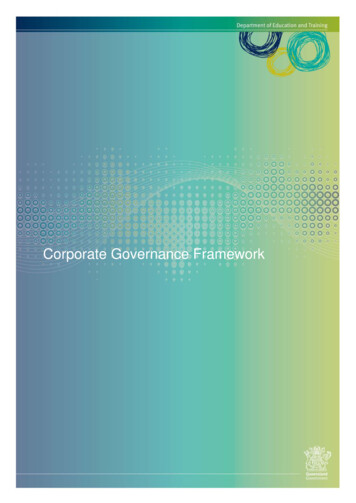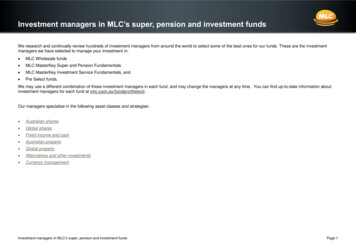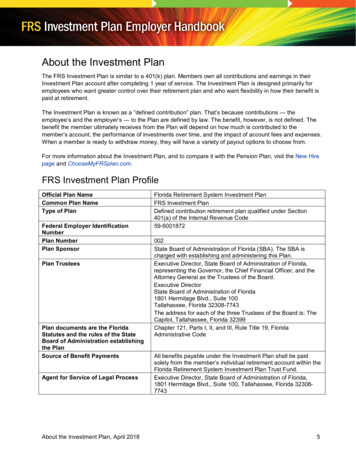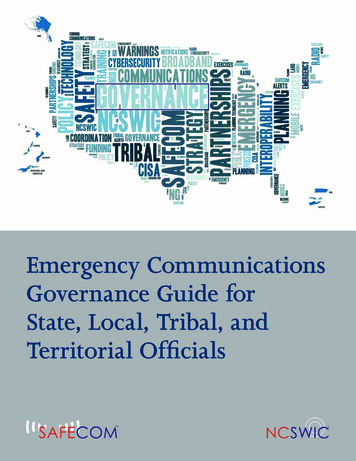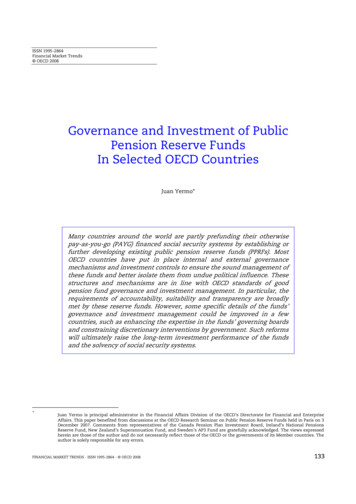
Transcription
ISSN 1995-2864Financial Market Trends OECD 2008Governance and Investment of PublicPension Reserve FundsIn Selected OECD CountriesJuan Yermo*Many countries around the world are partly prefunding their otherwisepay-as-you-go (PAYG) financed social security systems by establishing orfurther developing existing public pension reserve funds (PPRFs). MostOECD countries have put in place internal and external governancemechanisms and investment controls to ensure the sound management ofthese funds and better isolate them from undue political influence. Thesestructures and mechanisms are in line with OECD standards of goodpension fund governance and investment management. In particular, therequirements of accountability, suitability and transparency are broadlymet by these reserve funds. However, some specific details of the funds’governance and investment management could be improved in a fewcountries, such as enhancing the expertise in the funds’ governing boardsand constraining discretionary interventions by government. Such reformswill ultimately raise the long-term investment performance of the fundsand the solvency of social security systems.*Juan Yermo is principal administrator in the Financial Affairs Division of the OECD’s Directorate for Financial and EnterpriseAffairs. This paper benefited from discussions at the OECD Research Seminar on Public Pension Reserve Funds held in Paris on 3December 2007. Comments from representatives of the Canada Pension Plan Investment Board, Ireland’s National PensionsReserve Fund, New Zealand’s Superannuation Fund, and Sweden’s AP3 Fund are gratefully acknowledged. The views expressedherein are those of the author and do not necessarily reflect those of the OECD or the governments of its Member countries. Theauthor is solely responsible for any errors.FINANCIAL MARKET TRENDS - ISSN 1995-2864 - OECD 2008133
GOVERNANCE AND INVESTMENT OF PUBLIC PENSION RESERVE FUNDS IN SELECTED OECD COUNTRIESI. IntroductionThe growth in PublicPension Reserve Funds(PPRFs) is explained bythe shift towards prefunding social securitysystemsMany countries around the world are partly prefunding theirotherwise pay-as-you-go (PAYG) financed social security systems byestablishing or further developing existing public pension reserve funds.This trend is parallel to the growing shift towards fully-funded, privatelymanaged pension systems, which has in turn heightened the role ofpension funds in retirement income arrangements.PPRFs are similar topension funds but theirassets are owned by thepublic sector, nothouseholdsThe main defining feature of public pension reserve funds, whichdifferentiates them from pension funds, is that their ultimatebeneficiaries (the general population) do not have legal or beneficialownership over the reserve funds’ assets. Rather, the legal or beneficialowner is the institution that administers the public pension system(social security reserve funds - SSRFs) or the government (sovereignpension reserve funds - SPRFs). This feature of reserve funds exposesthem to potentially greater state influence than pension funds and hasbeen in the past one of the main reasons for favouring pension funds as away to prefund pension benefits.The OECD and ISSAgovernance andinvestment guidelinesoffer a benchmark forthe management ofthese fundsHowever, as shown in this paper, internal and external governancemechanisms and investment controls can be put in place in order toisolate reserve funds effectively from undue political influence. At aminimum, public pension reserve funds should be subject to similargovernance and investment management standards as pension funds,following the “OECD Guidelines on Pension Fund Governance” firstdeveloped by the Working Party on Private Pensions in 2001 and revisedin 2004 (OECD (2005a)) and the “OECD Guidelines on Pension Fund Asset1Management” (OECD (2006a)).The OECD governance and investment standards are also fullyconsistent with the “ISSA Guidelines for the Investment of Social SecurityFunds” developed by the International Social Security Association (ISSA,2005), which cover both governance and investment management issuesand used the OECD guidelines as a blueprint.Additional governancesafeguards are needed toprotect PPRFs frompolitical risks134The OECD and ISSA guidelines effectively address basic governanceand investment management issues. However, in the case of reservefunds additional safeguards are needed to promote better protectionfrom political manipulation of the funds. In particular, special care needsto be taken with the selection and appointment of the board of reservefunds, given their central responsibility in designing investment2strategies.FINANCIAL MARKET TRENDS - ISSN 1995-2864 - OECD 2008
GOVERNANCE AND INVESTMENT OF PUBLIC PENSION RESERVE FUNDS IN SELECTED OECD COUNTRIESThe report focuses on reserve funds in the following countries:Canada, France, Ireland, Japan, Korea, New Zealand, Norway andSweden. In general, these reserve funds show good levels of governance,but some weaknesses have been identified that call for reforms. Inparticular, two of these countries, Korea and Japan, are implementingreforms to their funds’ governance that should bring them further in linewith international good practices. The report also addresses someaspects of investment management, comparing the practices in thesecountries against the OECD and ISSA guidelines. The main concern is thepresence of some potentially restrictive investment rules in Sweden andpolitical influence on the investment policy in countries such as Korea,Japan and Norway, as decisions over the funds’ investment strategy areultimately taken by a government ministry or parliament.The policyrecommendations areparticularly relevant forPPRFs in non-OECDcountriesThe policy implications of this report are particularly relevant tomany non-OECD countries that have already or are in the process ofestablishing public pension reserve funds. Anecdotal evidence suggeststhat the internal governance features of some of these funds are weakand potentially exposed to undue political influence (see Impavido, 2002).The report is structured as follows. The next section discusses therationale for prefunding public pension systems via the establishment ofreserve funds. Section III presents the recent evolution of reserve fundsand the outlook for the future. Section IV and V discuss respectively themain aspects of the governance and investment of these funds, using theOECD and ISSA Guidelines as reference of good practices. The last sectionconcludes.II. Why and how are countries prefunding socialsecurity?PPRFs primarily help toaddress the fiscalimbalances of ageingpopulations, and canalso raise nationalsavings and improvediversificationPrefunding social security benefits can help governments respondmore effectively to the fiscal pressures that will result from ageingpopulations. While prefunding may not in itself offset the decline in3domestic growth rates that will result from worsening dependency ratiosit can help to solvent some aspects of the demographic shock. The mainreasons for prefunding via the establishment of reserve funds are: Tax-smoothing, that is, maintaining relatively constantcontribution rates to the social security system. While suchobjective could also be met by appropriate management of thepublic debt, assets in the reserve fund are assigned to financingthe social security system. Savings in the form of public debtreductions, on the other hand, may end up being used for otherfuture outlays of the government; Raising public savings and as a result, national savings. Byclearly assigning the reserve funds for future expenditure, thegovernment may have to reduce current expenditure or raiseFINANCIAL MARKET TRENDS - ISSN 1995-2864 - OECD 2008135
GOVERNANCE AND INVESTMENT OF PUBLIC PENSION RESERVE FUNDS IN SELECTED OECD COUNTRIEStaxes to maintain its fiscal objectives. Hence, the overall debtposition of the government may improve. Accessing output produced in foreign countries which may notbe suffering the same demographic shock. Again, such objectivecould be met through other means, such as redirecting privatesavings towards foreign assets. A reserve fund, however, may beable to take a longer horizon on these investments, hencereaping greater benefits from international diversification of lsystemsareunderdeveloped, prefunding via reserve funds may also contribute toeconomic growth by improving access to finance for productive activities.Around the world, countries have chosen different routes to prefundsocial security systems. Many OECD countries have recently establishedreserve funds, which complement a long tradition of pension fundprovision. The situation varies widely across non-OECD countries. InLatin America and most countries in Eastern Europe, pension funds havebeen recently established, partly replacing the PAYG financing system.This is leading to a rapid accumulation of funds in these countries. Inaddition, a few non-OECD countries, primarily in Asia, have relativelylarge reserve funds that support their social security systems, but arather small pension fund sector. Examples include China, Egypt, Jordan,Philippines and Saudi Arabia (see Blundell-Wignall et al (2008)).Prefunding via pensionfunds is generallypreferable to reservefundsIn general, prefunding via pension funds is preferable to reservefunds, as the former guarantee ownership or beneficial rights to pensionplan members and are normally subject to a comprehensive regulatoryand supervisory framework. Moreover, the financial advantages ofprefunding generally apply whether this takes place via pension funds orreserve funds. A preference for reserve funds may arise if there are costor/and investment performance advantages over privately managedpension funds, something which is unlikely to happen in countries withpoor public sector governance.There are two maintypes of PPRFs, those setup and owned directlyby government andthose owned by socialsecurity institutionsHistorically, reserve funds were managed as part of the socialsecurity scheme (social security reserve funds or SSRF), where the legalor beneficial owner is the scheme itself. More recently, somegovernments have established autonomous reserve funds that are underits direct ownership but are legally assigned to support the social securitysystem or more generally to address fiscal imbalances caused bydemographic ageing (sovereign pension reserve funds or SPRFs).The largest PPRF is theUnited States’ SocialSecurity Trust FundTable 1 shows the main SSRFs and SPRFs in OECD countries. Thetotal assets managed by these funds equalled USD 4.1 trillion inDecember 2006. By far the largest reserve fund in the world is the UnitedStates’ Social Security Trust Fund, with assets of over USD 2 trillion.However, all of its investments are non-tradable securities issued by the136FINANCIAL MARKET TRENDS - ISSN 1995-2864 - OECD 2008
GOVERNANCE AND INVESTMENT OF PUBLIC PENSION RESERVE FUNDS IN SELECTED OECD COUNTRIESUS Treasury. The second largest reserve fund is Japan’s, with assets overUSD 1.2 trillion in December 2006, the largest part of which is held at the4Government Pension Investment Fund. The third largest is Norway’s5Government Pension Fund-Global , with assets approaching US 280bn inDecember 2006, followed by Korea’s National Pension Fund, with assetsequal to US 190bn. The Japanese reserve fund is larger than any pensionfund in the world, while the Norwegian and Korean reserve funds alsorank among the ten largest pension-related institutional investors in theworld.Table 1. Public Pension Reserve Funds in selected OECD countriesCountryNameTypeSinceAUM(mn , 2006)United StatesSocial Security Trust FundSSRF19402 048 112JapanNational reserve funds (incl. GPIF)SSRF19591 217 551NorwayGovernment Pension Fund - GlobalSPRF1990278 124KoreaNational Pension FundSSRF1988190 842SwedenNational Pension Funds (AP 1-4 and 6)SPRF2000117 468CanadaCanada Pension Plan reserve fundSSRF196286 392SpainSocial Security Reserve FundSSRF199744 875FrancePension Reserve Fund (FRR)SPRF199939 140IrelandNational Pensions Reserve FundSPRF200123 710AustraliaFuture FundSPRF200613 678PortugalFinancial Stabilisation FundSPRF19898 330MexicoIMSS Reserve FundSSRFNew ZealandSuperannuation FundSPRF20016 666PolandDemographic Reserve FundSPRF20021 760DenmarkSocial Security FundSSRF19646597 392Source: OECD (2007).In some OECD countries,reserve funds manage abigger asset pool thanpension fundsWhile at a global level, the wealth accumulated in occupational andpersonal pension funds (USD 16 trillion) is still much greater than that inpublic pension reserve funds (USD 4 trillion), the situation is theopposite in some OECD countries. In Figure 1, the assets accumulated inreserve funds are compared against those of pension funds. In a fewcountries (France, Japan, Korea, Norway and Sweden), reserve funds haveactually accumulated more assets than pension funds.FINANCIAL MARKET TRENDS - ISSN 1995-2864 - OECD 2008137
GOVERNANCE AND INVESTMENT OF PUBLIC PENSION RESERVE FUNDS IN SELECTED OECD COUNTRIESFigure 1. Reserve funds and pension funds in selected OECD countriesUSD billion, 20061 217.551 .47Pension Funds600200Reserve funds6798006871 0000Source: OECD (2007).III. Recent evolution of reserve funds and outlookfor the futurePPRFs are only expectedto cover a small part ofpublic pension liabilities.Unlike pension funds, reserve funds support what are otherwisePAYG-financed pension systems and are generally not expected to coverbut a small part of the social security system’s liabilities. For example,the Portuguese reserve fund (the so-called Social Security FinancialStabilisation Fund) is expected by law to receive every year between 2and 4 percent of the obligatory contributions paid by employees to thesocial security system until it accumulates assets equivalent to two yearsof social security benefits. The fund was established in 1989 and byDecember 2006 had USD 8.3 bn in assets, equivalent to 5% of GDP.Sweden’s reserve fund is actually a group of competing and independentfunds (the AP-Fonden 1 to 4 and AP6) which were established in May 2000from the existing ATP fund, which had been established in 1960.Some recentlyestablished reservefunds are amassing alarge amount of capitalSome of the more recently established reserve funds, which are alsoof the sovereign type, have grander ambitions. Examples of SPRFs thatare destined to accumulate large assets include the following: France’s Pension Reserve Fund (FRR): The fund was set up in1999 and by December 2006 had assets of USD39 billion (31billion euros). The part of the projected PAYG shortfalls that theFund will finance from 2020 onwards will depend on thefunding it will receive until this date. Up until now, the fund has138FINANCIAL MARKET TRENDS - ISSN 1995-2864 - OECD 2008
GOVERNANCE AND INVESTMENT OF PUBLIC PENSION RESERVE FUNDS IN SELECTED OECD COUNTRIESbeen receiving a varying annual contribution from thegovernment, ranging from 5.5 billion euros in 2002 to 1.5 billioneuros in 2006. Financing comes from surpluses from theNational Old Age Insurance Fund for Wage Earners, the Old AgeSolidarity Fund, additional taxes on private assets, andcontributions from savings banks and the Deposit and SecuritiesFund plus infrequent cash injections. Some funding also comesfrom asset sales: starting in 2000, the bulk of the revenuegenerated by the sale of licenses for third generation cellulartelephones will also be transferred to the FRR. Ireland’s National Pensions Reserve Fund: The NationalPensions Reserve Fund Act that established the reserve fund in2001 stipulates explicitly that utilisation of the fund to coverdeficits in the social security system will only become possiblefrom 2025 onwards. As the fund receives 1% of GNP every yearfrom the government (until at least 2055, as stated in theNational Pension Reserves Fund Act), it is expected toaccumulate assets representing up to 45% of the country’s GDP.At its founding in 2001, the fund also received part of proceedsfrom the privatisation of Telecomm Éireann. New Zealand’s Superannuation Fund: This fund was establishedin 2001 to partially provide for the future cost of superannuationpayments. The government’s annual contribution is determinedby an actuarial formula (which is in the legislation) and isexpected to average NZD 2.2 billion a year (around 0.75% of GDP)until 2025. The actuarial formula also determines the rate atwhich the government can draw down the funds, but nowithdrawals are possible before 2020. In the drawdown period,expected to begin in 2028, the government expects to draw theequivalent of between 15 to 20 per cent of the annual cost ofsuperannuation payments. In December 2006, the fund had NZD11.9 billion in invested assets (over 6% of GDP) and is expectedto peak at around 33% of GDP in 2037. Norway’s government pension fund – global: This fund,previously known as the Norwegian petroleum fund, wasestablished in 1990. The name change occurred in January 2006.By law, transfers from the fund are limited to four percent of thecapital a year, which is equal to the estimated long-term realrate of return from the fund. The fund already had assetsrepresenting 83% of the country’s GDP in December 2006 and isprojected to reach USD 800-900 billion in assets by 2017.The rapid growth of SPRFs relative to SSRFs can be observed inFigure 2, which compares the largest reserve funds relative to GDP ineach country. The two largest reserve funds in relative terms are of theSPRF variety. The highest rate of growth in 2005-6 was observed in NewZealand, followed by Spain, Norway, and Ireland, all of which, exceptSpain, are of the sovereign type.FINANCIAL MARKET TRENDS - ISSN 1995-2864 - OECD 2008139
GOVERNANCE AND INVESTMENT OF PUBLIC PENSION RESERVE FUNDS IN SELECTED OECD COUNTRIESFigure 2. Assets accumulated in reserve fundsIn per cent of GDP and growth 2005-6Notes: (1) Japanese data is from fiscal year 2005-6. (2) Polish data refers to 2005.Source: OECD (2007).IV. The governance of reserve fundsGood governance ofPPRFs is essential tomeet their goalsEnsuring good governance of reserve funds is essential to meet theirgoal of financing public pension systems. Given the size of reserve fundsin many countries, their governance has also major implications for thebehaviour of the financial system. A particular concern in the governanceof reserve funds is how to ensure sufficient independence from unduepolitical interference.The OECD guidelines onpension fundgovernance andinvestment can also beapplied to reserve fundsReserve funds, like pension funds, require a governance structurethat ensures an appropriate division of operational and oversightresponsibilities, and the suitability and accountability of those with suchresponsibilities. This basic principle of governance is enshrined in boththe OECD’s “Guidelines on Pension Fund Governance” and ISSA’s“Guidelines for the Investment of Social Security Funds”.Clear fiduciary duties forthe governing body areessentialBoth sets of guidelines contain similar criteria to implement thisobjective. At the centre of the governance structure is a governing bodythat has ultimate responsibility for the fund and is accountable to itsbeneficiaries. The members of this body must have clear fiduciary duties140FINANCIAL MARKET TRENDS - ISSN 1995-2864 - OECD 2008
GOVERNANCE AND INVESTMENT OF PUBLIC PENSION RESERVE FUNDS IN SELECTED OECD COUNTRIESand a specific, measurable mandate, and must possess relevant expertiseto be able to carry out their functions.The governing body may be a government ministry, the board of thesocial security institution or the board of an entity established expresslyfor the purpose of investing the scheme’s funds. The latter, segregatedset-up may be preferable as a protection against political interference,especially if a government ministry is responsible for administering thesocial security scheme.The governing body isusually assisted by aninvestment committeeThe governing body is usually assisted by an investment committeewhich advises on the investment strategy, and an executive that is incharge of operational management, including asset management. Assetmanagement may also be delegated externally, but the governing bodyshould retain the fiduciary responsibility for the fund. Where thegoverning body does not possess sufficient knowledge to discharge itsduties, it should also seek external advice.The governance structure of reserve funds (like that of pensionfunds) should normally include three other bodies. An independentauditor should be appointed to carry out an annual audit of the fund. Inthe case of funds that are integrated in the social security institution, anactuary would also need to be appointed to carry out the actuarialvaluations of the system and analyse the implications of differentinvestment strategies for the system’s financing. In most instances, it isalso a good practice to appoint a custodian who is in charge of thesafekeeping of the assets.Good governance also calls for effective mechanisms of internal andexternal control. According to the OECD guidelines for pension fundgovernance (again, in common with the ISSA guidelines), reserve fundsshould have appropriate control, communication and incentivemechanisms that encourage good decision-making, proper and timelyexecution, transparency and regular review and assessment. Controlsystems should include a code of conduct and mechanisms to addressesconflict of interest situations. Reserve funds should also be required todisclose publicly relevant information and should have procedures inplace to address complaints from the general public.Additional checks andbalances are needed toprotect reserve fundsfrom political riskWhile all these basic features of governance are common to bothreserve funds and pension funds, reserve funds also face some uniquechallenges that call for greater care in the governance design andpossibly additional constraints and requirements on the governing bodyand other parties that partake in the governance of the fund. Thechallenges specific to reserve funds include the following: Reserve funds are established by the government, the socialsecurity institution, or some other public sector entity. Thegovernment selects at least some of the members of theFINANCIAL MARKET TRENDS - ISSN 1995-2864 - OECD 2008141
GOVERNANCE AND INVESTMENT OF PUBLIC PENSION RESERVE FUNDS IN SELECTED OECD COUNTRIESgoverning body, and may influence its decisions, either directly(through regulations), or indirectly, through political influence.This political risk, which also affects pension funds forgovernment workers, can endanger the effective governance ofthe fund. Unlike pension funds, reserve funds are not usually subject tothe supervision of an independent supervisory authority. Theaccountability of the governing body therefore relies on publicdisclosure of its operations (such as an annual report containingthe accounts verified by an independent auditor) and anyreporting requirements to the government, parliament or thepublic controller. Reserve funds do not normally have national competitors oreven peers, as is the case with pension funds. Hence, theirperformance (including not just investment performance butalso their operational efficiency) can only be benchmarkedagainst any initial objectives set or, as far as relevant, againstforeign reserve funds.Reserve funds support pension systems that do not have a fullfunding goal in mind. Hence, investment objectives may not be readilyestablished with regards to liabilities, time horizon or risk aversion.Given these difficulties, reserve funds are in need of specificgovernance structures and mechanisms to protect them from politicalrisk while ensuring their accountability to the general public. Theseadditional features of reserve fund governance can be observed in aselection of reserve funds (both SSRFs and SPRFs) around the world,which rank among the largest in terms of assets as a percentage of GDP.Legal separation and ring-fencingThe legal separation ofassets, or at least itsring-fencing, enhancestransparency and helpsprevent misuse of thefundsFrom a governance perspective, the key difference between SSRFsand SPRFs is that the latter involves a strict legal separation of thereserve fund’s assets from other assets of the social security system. Associal security systems offer services other than pensions, such as healthor family benefits, the mingling of reserve fund assets with otherresources of the social security system can lead to misuse, such as adiversion of pension assets to cover deficits in non-pension branches ofsocial security.While this justification has some merit, legal separation is not ascritical as it is in the case of pension funds, where it is used to protectpension assets from company insolvency. Regardless of whether thereserve fund is legally separated from the scheme, the legal title to theassets is by necessity in the hands of the public sector. In the case of aSSRF, the social security institution holds the legal title to the assets, and142FINANCIAL MARKET TRENDS - ISSN 1995-2864 - OECD 2008
GOVERNANCE AND INVESTMENT OF PUBLIC PENSION RESERVE FUNDS IN SELECTED OECD COUNTRIEShence the government is an indirect owner. In the case of a SPRF thegovernment holds directly the legal title to the reserve fund’s assets. Yet,the government can also be tempted to use the funds for other purposesthan pension financing.Hence, rather than requiring the legal separation of the reserve fundfrom the social security institution, what is essential is to ensure that thefund is used only for pension financing. This can be achieved via socalled “ring-fencing”, which in the case of a reserve fund consists in lawsstating that the assets of the reserve fund are to be used exclusively forthe payment of pensions. Such laws are applied to some SSRFs, such asthe Canada Pension Plan reserve fund, while most SPRFs are subject tothem. The main exception is Norway’s Government Pension Fund. Itsfounding act states that it “shall support central government saving tofinance the National Insurance Scheme’s expenditure on pensions andlong-term considerations in the application of petroleum revenues.“ Thebroader mandate, while granting flexibility to the government’s fiscalobjectives, obscures the financing of the social security system.The governing body and the management entityThe governing body isthe ultimate decisionmakerThe governing body is the central strategic decision-making organ ofa reserve fund. Its main function is approving the investment policy forthe fund, and specifically, the strategic asset allocation. The governingbody also monitors the executive and operational staff of the fund and isresponsible for fulfilling the fund’s mission and complying withregulations. As shown in Table 2, the governing body of some reservefunds is a stand-alone board or committee. In most cases, though, thegoverning body is integrated in the management entity which isresponsible for the administration of the fund.Reserve funds of thesocial security type tendto be run by tripartiteboardsGiven the critical importance of the governing body, it isunderstandable that efforts at insulating reserve funds from political riskhave focused on it. Under the SSRF structure, the governing body istypically the tripartite board of the social security institution, whosemembers are selected by the government, and representatives ofemployers (e.g. employer associations) and workers (typically labourunions). There are, however, some exceptions. In Canada, for example,the reserve fund is under the direct responsibility of the board of a Crowncorporation, the Canada Pension Plan (CPP) Investment Board. In Korea,the reserve fund is under the direct responsibility of the NationalAssembly and the management entity is the National Pension Service,Korea’s social security institution.FINANCIAL MARKET TRENDS - ISSN 1995-2864 - OECD 2008143
GOVERNANCE AND INVESTMENT OF PUBLIC PENSION RESERVE FUNDS IN SELECTED OECD COUNTRIESTable 2. Management entities and governing body of reserve fundsCountryManagement EntityGoverning bodyCanadaCanada Pension Plan (CPP)Investment Board (a public sectorcorporation)Board of Directors of theCPP Investment BoardFrancePension Reserve Fund (FRR)Supervisory Board of theFRRIrelandNational Treasury rnment Pension InvestmentFund (GPIF)Chairman of the GPIFand Ministry of Health,Labour and WelfareKoreaFund Management Centre of theNational Pension Service (thecountry’ssocialsecurityinstitution)National AssemblyNew ZealandGuardians of New ZealandSuperannuation (a public sectorcorporation)Board of the kInvestmentManagement (an arm of theCentral Bank) for the “Global”fund and “Folketrygdfondet”(National Insurance Fund) for the“Norway” fundNorwegianparliamentand Ministry of FinanceSwedenAP FondenBoard of Directors of theAP FondenPensionsFundSource: OECD.Reserve funds of thesovereign type tend tobe run by independentmanagement agencies144Under the SPRF structure, the governing body is either an independentcommittee (like the National Pensions Reserve Fund Commission inIreland) or the highest organ of an independent legal entity that isexclusively responsible for the management of the reserve fund (like theBoard of the Guardians of New Zealand Superannuation). Japan andNorway are the main exceptions to such an arrangement. In Japan, theinvestment strategy, one of the key responsibilities of the governing body,is decided by the Ministry of Health, Labour and Welfare, after consultingwith the chairman a
Government Pension Investment Fund.4 The third largest is Norway's Government Pension Fund-Global5, with assets approaching US 280bn in December 2006, followed by Korea's National Pension Fund, with assets equal to US 190bn. The Japanese reserve fund is larger than any pension fund in the world, while the Norwegian and Korean reserve funds also
